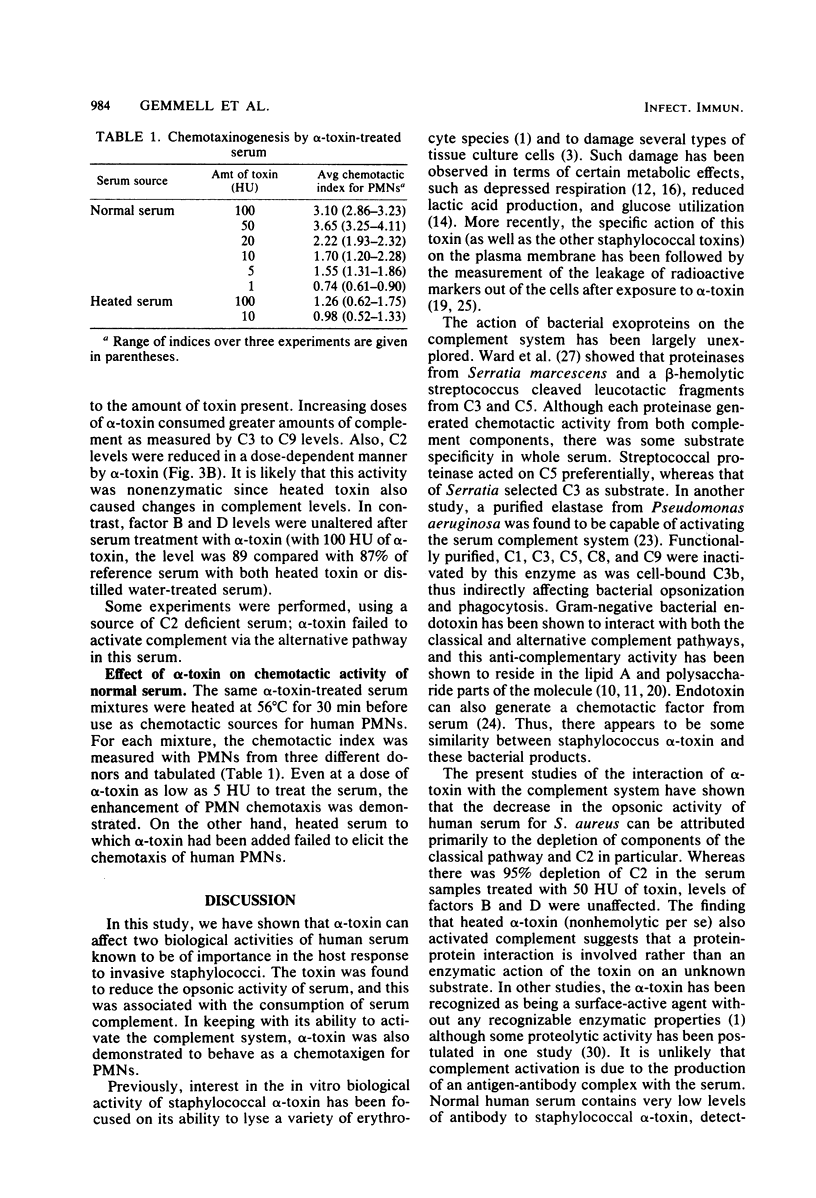Abstract
The alpha-toxin (hemolysin) of Staphylococcus aureus is known to be an important determinant of pathogenicity although its precise role in the process of infection is not understood. In this study, the interaction of alpha-toxin with the human complement system was evaluated in terms of its effect on the opsonic activity of serum for S. aureus. Phagocytosis by human polymorphonuclear leukocytes was studied by measuring the uptake of preopsonized radiolabeled bacteria. It was found that alpha-toxin-treated serum had reduced opsonic activity and that this change was associated with complement consumption via the classical pathway. Levels of C3 to C9 were reduced in proportion to the amount of toxin added to the reaction mixture; levels of C2 were markedly reduced but those of factors B and D of the alternative pathway were unaltered in the presence of alpha-toxin. Heat-inactivated toxin, which had no hemolytic activity, also interacted with the complement system but with a significantly reduced effect. In addition, alpha-toxin behaved as a chemotaxinogen for polymorphonuclear leukocytes: human serum was activated by the toxin. These studies demonstrate that the interaction of staphylococcus alpha-toxin with human serum affects two important aspects of the host response to the staphylococcus.
Full text
PDF




Selected References
These references are in PubMed. This may not be the complete list of references from this article.
- Arbuthnott J. P., Freer J. H., Bernheimer A. W. Physical states of staphylococcal alpha-toxin. J Bacteriol. 1967 Oct;94(4):1170–1177. doi: 10.1128/jb.94.4.1170-1177.1967. [DOI] [PMC free article] [PubMed] [Google Scholar]
- BERNHEIMER A. W., SCHWARTZ L. L. Isolation and composition of staphylococcal alpha toxin. J Gen Microbiol. 1963 Mar;30:455–468. doi: 10.1099/00221287-30-3-455. [DOI] [PubMed] [Google Scholar]
- Ballow M., Fang F., Good R. A., Day N. K. Developmental aspects of complement components in the newborn. The presence of complement components and C3 proactivator (properdin factor B) in human colostrum. Clin Exp Immunol. 1974 Oct;18(2):257–266. [PMC free article] [PubMed] [Google Scholar]
- Borsos T., Rapp H. J. Immune hemolysis: a simplified method for the preparation of EAC'4 with guinea pig or with human complement. J Immunol. 1967 Aug;99(2):263–268. [PubMed] [Google Scholar]
- FOSTER W. D. THE ROLE OF ALPHA-HAEMOLYSIN IN THE PATHOGENICITY OF STAPHYLOCOCCUS AUREUS. J Pathol Bacteriol. 1963 Oct;86:535–541. doi: 10.1002/path.1700860231. [DOI] [PubMed] [Google Scholar]
- Freudenberg M. A., Galanos C. Interaction of lipopolysaccharides and lipid A with complement in rats and its relation to endotoxicity. Infect Immun. 1978 Mar;19(3):875–882. doi: 10.1128/iai.19.3.875-882.1978. [DOI] [PMC free article] [PubMed] [Google Scholar]
- Galanos C., Rietschel E. T., Lüderitz O., Westphal O. Interaction of lipopolysaccharides and lipid A with complement. Eur J Biochem. 1971 Mar 1;19(1):143–152. doi: 10.1111/j.1432-1033.1971.tb01298.x. [DOI] [PubMed] [Google Scholar]
- Galanti B., Paradisi F., Mancini A., Giusti G. An early effect of Staphylococcus alpha-toxin on cells growing in culture: ATP levels in normal and intoxicated cells. Pathol Microbiol (Basel) 1968;32(5):277–284. doi: 10.1159/000162068. [DOI] [PubMed] [Google Scholar]
- Gewurz H., Page A. R., Pickering R. J., Good R. A. Complement activity and inflammatory neutrophil exudation in man. Studies in patients with glomerulonephritis, essential hypocomplementemia and agammaglobulinemia. Int Arch Allergy Appl Immunol. 1967;32(1):64–90. doi: 10.1159/000229917. [DOI] [PubMed] [Google Scholar]
- KORBECKI M., JELJASZEWICZ J. EFFECT STAPHYLOCOCCAL ALPHA-HAEMOLYSIN ON KB CELLS. Zentralbl Bakteriol Orig. 1964 May;192:430–433. [PubMed] [Google Scholar]
- LAWRENCE J. C. Some effects of staphylococcal and streptococcal toxins upon mammalian skin in tissue culture. Br J Exp Pathol. 1959 Feb;40(1):8–14. [PMC free article] [PubMed] [Google Scholar]
- LOMINSKI I., ARBUTHNOTT J. P. Some characteristics of Staphylococcus alpha haemolysin. J Pathol Bacteriol. 1962 Apr;83:515–520. [PubMed] [Google Scholar]
- LOWRY O. H., ROSEBROUGH N. J., FARR A. L., RANDALL R. J. Protein measurement with the Folin phenol reagent. J Biol Chem. 1951 Nov;193(1):265–275. [PubMed] [Google Scholar]
- Morrison D. C., Kline L. F. Activation of the classical and properdin pathways of complement by bacterial lipopolysaccharides (LPS). J Immunol. 1977 Jan;118(1):362–368. [PubMed] [Google Scholar]
- Nelson R. A., Jr, Jensen J., Gigli I., Tamura N. Methods for the separation, purification and measurement of nine components of hemolytic complement in guinea-pig serum. Immunochemistry. 1966 Mar;3(2):111–135. doi: 10.1016/0019-2791(66)90292-8. [DOI] [PubMed] [Google Scholar]
- Peterson P. K., Kim Y., Schmeling D., Lindemann M., Verhoef J., Quie P. G. Complement-mediated phagocytosis of Pseudomonas aeruginosa. J Lab Clin Med. 1978 Dec;92(6):883–894. [PubMed] [Google Scholar]
- Schultz D. R., Miller K. D. Elastase of Pseudomonas aeruginosa: inactivation of complement components and complement-derived chemotactic and phagocytic factors. Infect Immun. 1974 Jul;10(1):128–135. doi: 10.1128/iai.10.1.128-135.1974. [DOI] [PMC free article] [PubMed] [Google Scholar]
- Snyderman R., Gewurz H., Mergenhagen S. E. Interactions of the complement system with endotoxic lipopolysaccharide. Generation of a factor chemotactic for polymorphonuclear leukocytes. J Exp Med. 1968 Aug 1;128(2):259–275. doi: 10.1084/jem.128.2.259. [DOI] [PMC free article] [PubMed] [Google Scholar]
- Thelestam M., Möllby R., Wadström T. Effects of staphylococcal alpha-, beta-, delta-, and gamma-hemolysins on human diploid fibroblasts and HeLa cells: evaluation of a new quantitative as say for measuring cell damage. Infect Immun. 1973 Dec;8(6):938–946. doi: 10.1128/iai.8.6.938-946.1973. [DOI] [PMC free article] [PubMed] [Google Scholar]
- Verhoef J., Peterson P. K., Quie P. G. Kinetics of staphylococcal opsonization, attachment, ingestion and killing by human polymorphonuclear leukocytes: a quantitative assay using [3H]thymidine labeled bacteria. J Immunol Methods. 1977;14(3-4):303–311. doi: 10.1016/0022-1759(77)90141-7. [DOI] [PubMed] [Google Scholar]
- Ward P. A., Zvaifler N. J. Complement-derived leukotactic factors in inflammatory synovial fluids of humans. J Clin Invest. 1971 Mar;50(3):606–616. doi: 10.1172/JCI106531. [DOI] [PMC free article] [PubMed] [Google Scholar]
- Wilkinson B. J., Kim Y., Peterson P. K., Quie P. G., Michael A. F. Activation of complement by cell surface components of Staphylococcus aureus. Infect Immun. 1978 May;20(2):388–392. doi: 10.1128/iai.20.2.388-392.1978. [DOI] [PMC free article] [PubMed] [Google Scholar]
- Wiseman G. M., Caird J. D. Further observations on the mode of action of the alpha toxin of Staphylococcus aureus "Wood-46". Can J Microbiol. 1972 Jul;18(7):987–992. doi: 10.1139/m72-153. [DOI] [PubMed] [Google Scholar]


